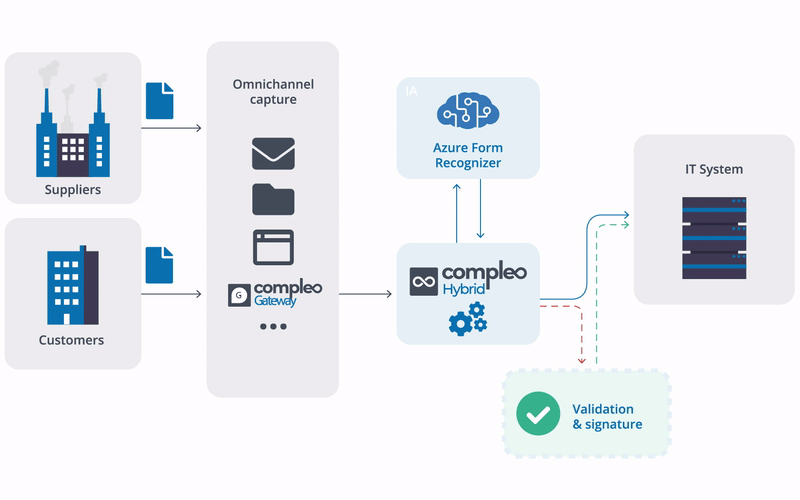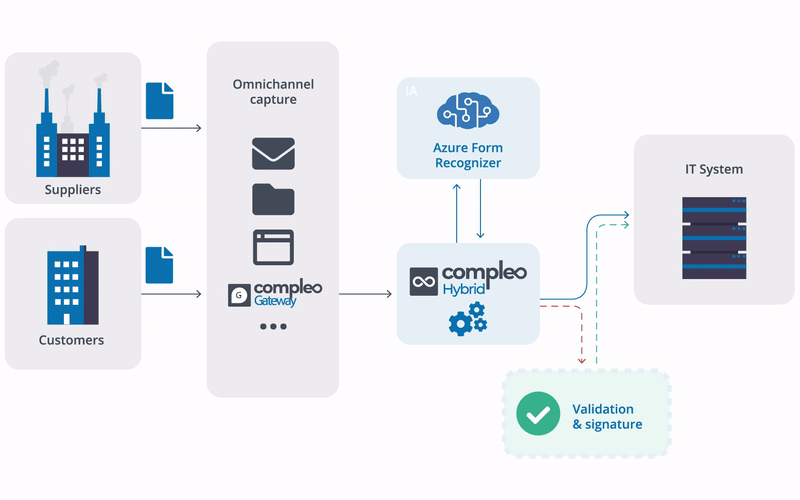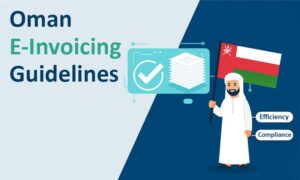Is your organization struggling with manually handling invoices, purchase orders, and contracts document, despite having advanced digital systems? Do you find it time-consuming and error-prone to manage and process incoming documents manually? Do you think automating this process will save a lot of resources, make your processes more efficient, increase business productivity, and improve your cash flows?
Consider intelligent automation for data processing and real-time entry into your system, leading to improved lead time for document processing.

Did you know that organizations spend an average of 20% of their time searching for and recreating lost documents? That’s valuable time that could be better spent on important tasks. And it’s not just about the time wasted – the cost of manual document management can be staggering. Studies show that companies can spend up to $20 in labor costs to file a single document, and an additional $120 to find a misfiled document. These numbers highlight the inefficiencies and financial strain that manual document management can bring.
The benefits of automating incoming documents include but are not limited to:
- Cost savings and resource optimization: While not explicitly mentioned, automating incoming document management indirectly leads to cost savings and resource optimization by reducing manual errors, minimizing storage and printing costs, and optimizing employee productivity.
- Enhanced business agility: By automating incoming document management, organizations can scale operations and stay ahead of the competition while achieving their goals swiftly.
- Initiates reciprocated document creation process: Automation ensures that initiation of generating outgoing or internal documents for the received incoming documents is automatic. Upon receiving a purchase order, for example, the automation module triggers the generation of a sales order. Similarly, when an invoice is received, its data is recognized, reviewed, and seamlessly pushed to the ERP system, where 3-way matching is conducted for accuracy and completeness.
- Faster approvals: Automating the process of approvals for incoming documents eliminates the need for manual routing and follow-ups, significantly reducing the time it takes to get the necessary approvals.
- Automated notification to respective teams: With automation, notifications about the status of the document, its authorization status, and the updates of the document life cycle are automatically sent to the relevant teams and authorities via email. This eliminates the need for manual communication and ensures prompt action on important documents. It ensures that no document is left unattended.
- Identification and notification of discrepancies: Automation systems can detect discrepancies in incoming documents and promptly notify the respective departments and the client. This helps in resolving issues and errors quickly.
- Enhanced control over captured process data: AI/ML and OCR technologies ensure data extraction with greater precision allowing you to review the captured data from incoming documents. You can define specific conditions and criteria for data validation and verification, ensuring that only accurate and relevant information is processed further and integrated with your ERP.
Additional Intangible Benefits:
- Accelerated decision-making: Instant access to documents and information empowers quicker decision-making processes, resulting in heightened responsiveness to customer demands, market shifts, and business prospects.
- Aid in strategies: Expedited data processing facilitates efficient inventory management, enabling the realization of lean management and Just-In-Time (JIT) goals, ultimately leading to superior inventory control. Automation can predominantly improve your organization’s internal processes.
- Competitive advantage: By embracing automation in document management, businesses gain a competitive edge in today’s digital age. They can deliver faster, more accurately, and efficiently with document management processes, setting themselves apart from competitors still relying on manual methods.

If you want to streamline your document management processes through automation, here’s what you should do.
To ensure a successful automation journey, follow a systematic approach. Begin by analysing your current manual processes and identifying pain points in the system. Set clear objectives and goals for automation implementation, prioritizing your needs.
Next, search for the appropriate solution and provider that aligns with your goals. Request demos or trials to assess user-friendly functionalities. Allocate sufficient resources and budget for implementation. Finalize a vendor within your budget that meets all requirements.
By following this step-by-step process, you’ll achieve a seamless automation implementation, optimizing efficiency and productivity across your organization. To ensure seamless integration with your existing systems and workflows, collaborate closely with your IT teams. They can help you evaluate compatibility and integration requirements with your IT production systems or databases. Decide the implementation pace and degree according to the scope, preparation for acceptance of the team, and budget allocation, ensuring your plan is practical all throughout.
To get a detailed understanding of the best way to implement IPA read this blog.
On successful implementation be prompt in recording the statistical benefits and areas of optimization for future optimization.
Automating incoming document management is essential for modern organizations to improve efficiency, accuracy, and productivity. Automation is not just a trend but a strategic investment that can revolutionize your management practices and unlock new levels of efficiency and effectiveness.
Remember, the benefits of automating incoming documents extend beyond efficiency and cost savings. It is about empowering your employees, enhancing customer experiences, and driving sustainable growth. So, take the first step of automating your incoming document management processes today. Your business will thank you for it!


